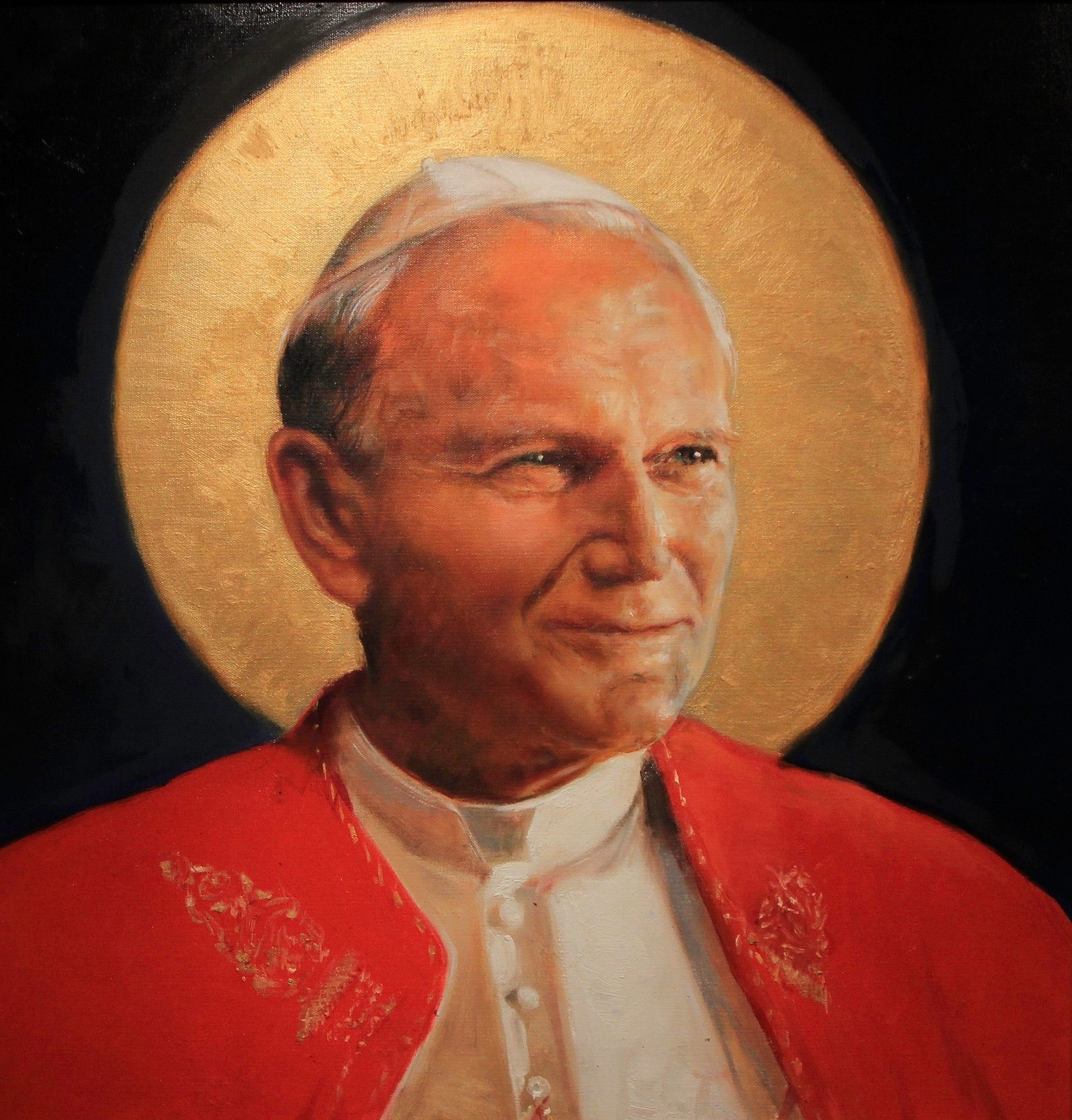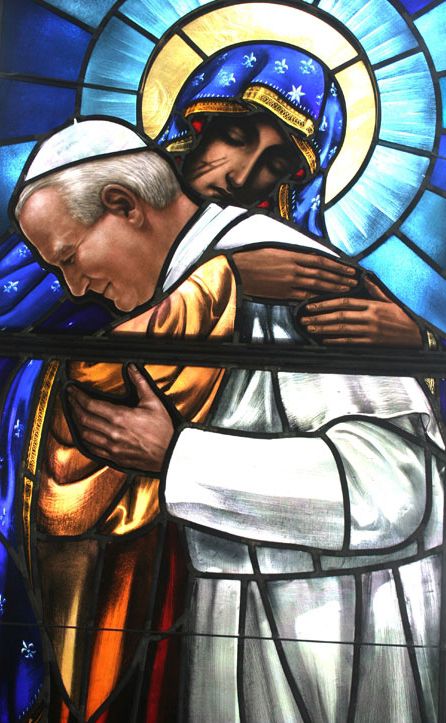The following is the first part of an explanation of Pope John Paul II’s papal motto: “Totus Tuus.” It appeared on the Vatican’s official web-site of the Central Committee
Saint Pope John Paul II
T he “Totus Tuus” of John Paul II has resounded in the Church since the beginning of his ministry as Universal Pastor. In his first radio message “Urbi et orbi” recalling his election to be Supreme Pontiff, the Pope said: “ . . . at this time of grave anxiety for us, we cannot fail to turn our attention with filial devotion to the Virgin Mary, who always lives and works as Mother in the mystery of Christ and of the Church, repeating the sweet words “Totus Tuus” which [in 1980] we inscribed in our heart and on our coat of arms at the time of our Epscopal Ordination . . . ”
In his book “Gift and Mystery,” the Holy Father explains to us the origin of the “Totus Tuus”:
“It was a moment in which I to some extent debated about my devotion toward Mary, thinking that if it spread too far it would end up by compromising the supremacy of the worship due to Christ. The book of St. Louis Maria Grignion de Montfort then helped me: “Treatise of the True Devotion to the Holy Virgin.” In it I found the answer to my perplexities . . . The author is an excellent theologian. His Mariological thought is rooted in the Trinitarian Mystery and in the truth of the Incarnation of the Word of God . . . Here is the explanation of the origin of the Totus Tuus. The expression comes from St. Louis Maria Grignion of Montfort. It is the abbreviation of the more complete form of entrusting oneself to the Mother of God.”
The Marian dimension of the life of a disciple of Christ is expressed in a special way precisely through this filial entrusting to the Mother of Christ, who began with the testament of the Redeemer on Golgotha. Entrusting himself to Mary in a filial manner, the Christian, like the Apostle John, “welcomes” the Mother of Christ “into his own home” and brings her into everything that makes up his inner life, that is to say into his human and Christian “I”: he “took her to his own home.” Thus the Christian seeks to be taken into that “maternal charity” with which the Redeemer’s Mother “cares for the brethren of her Son.” “In whose birth and development she cooperates” in the measure of the gift proper to each one through the power of Christ’s Spirit. Thus also is exercised that motherhood of the Spirit which becomes Mary’s role at the foot of the Cross and in the Upper Room.
The Holy Father returns many times in his Magisterium to meditate those two verses of filial entrusting in the Gospel of John (Jn 19:26-27), as for instance in the general audience of November 23 1988:
“But that solemnity of filial entrusting “Woman, here is your son”, his placing it at the very heart of the drama of the cross, that sobriety and essentiality of words which could be considered proper to a quasi sacramental, make one think that, over and above the familiar relations, the fact must be considered in the perspective of the work of salvation, where the woman-Mary was engaged with the Son of man in the redemptive mission.”
“. . . Her Son explicitly extended his Mother’s maternity in a way that could easily be understood by every soul and every heart by designating, when he was raised up on the Cross, his beloved disciple as her son . . . Later, all the generations of disciples, of those who confess and love Christ, like the Apostle John, spiritually took this Mother to their own homes, and she was thus included in the history of salvation and in the Church’s mission from the very beginning, that is from the moment of the Annunciation. Accordingly, we who form today’s generation of Disciples of Christ all wish to unite ourselves with her in a special way . . . If in fact we feel a special need, in this difficult and responsible phase of the history of the Church and of mankind, to turn to Christ, who is the Lord of the Church and Lord of man’s history on account of the mystery of the Redemption, we believe that nobody else can bring us as Mary can into the divine and human dimension of this mystery. Nobody has been brought into it by God himself as Mary has. It is in this that the exceptional character of the grace of the divine Motherhood consists . . . For this reason her heart must also have the inexhaustibility of a mother. The special characteristic of the motherly love that the Mother of God inserts in the mystery of the Redemption and the Life of the Church finds expression in its exceptional closeness to man and all that happens to him. It is in this that the mystery of the Mother consists. The Church which looks to her with altogether special love and hope, wishes to make this mystery her own in an ever deeper manner … Consequently, Mary must be on all the ways for the Church’s daily life. Through her maternal presence the Church acquires certainty that she is truly living the life of her Master and Lord and that she is living the mystery of the Redemption in all its life-giving profundity and fullness . . . “


Here is the explanation of the origin of the Totus Tuus. The expression comes from St. Louis Maria Grignion of Montfort. It is the abbreviation of the more complete form of entrusting oneself to the Mother of God.”
The Pope seems to have pointed out to us in the “Totus Tuus,” the expression of full and joyous acceptance of the spiritual maternity of the Virgin Mary, the prompt response to the invitation of Jesus: “This is your Mother” (Jn 19:27). It is the Mother who introduces us into the Mystery of the Son. It is on Golgotha, that the Holy Father makes us contemplate the zenith of the Marian dimension; it is here in the extreme sacrifice of Christ Redeemer, the “Totus Tuus” began, entrusting the Church and the entire humanity to Mary, Co-redemptrix, was put into effect by Jesus himself. Through the centuries that same “act of entrustment” is perpetuated, which rooted in the salvific will of the Christ Crucified, has a value that surpasses space and time, extends beyond the confines of Palestine and running through the whole human history, reaches today also each one of us. John Paul II, with the “Totus Tuus” has placed before our conscience, the “sacred consignment” of Christ from the Cross, he has invited us to walk with Mary.
“In the most sacred and solemn moment of his life, Christ has made us the most precious gift. It was his last will, his most dear treasure, Mary, his Mother. These were his last words, which we have heard a moment ago. It’s the “testament of the Cross”: “Jesus, then, seeing the mother there beside her the disciple whom he loved, said to the mother, “Woman, here is your Son!” Then the disciple said: “Here is your mother!” (Jn 19:26-27). With this consignment, Jesus gave Mary as Mother to all humanity in the person of John, the beloved young disciple. In this way, Jesus Christ transforms all the redeemed into sons of Mary. From this moment, no one in the world will be really alone and abandoned in the vicissitudes of life. Youths, Mary walks with you! She also, besides her Son, repeats to us: “Fear not, I am with you till the end of the world.” Christ has given us the most beautiful of gifts: to continue to be present among us through the solicitudes and maternal protection of Mary of Nazareth.” (May 8 1990).
At Fatima, in his homily of May 13, 1982, John Paul II speaks to us of the meaning of consecrating the world to the immaculate Heart of Mary. A fundamental text to understand the universal “Totus Tuus”:
“To consecrate the world to the Immaculate Heart of Mary means to draw us, through the intercession of the Mother, near to the same source of Life, that flowed forth on Golgotha. This Source without interruption springs forth with the redemption and grace. Continuously, there is accomplished in it reparation for the sins of the world. It is incessantly the source of new life and sanctity.
To consecrate the world to the Immaculate Heart of Mary, means to return at the foot of the Cross of the Son. Furthermore it means to consecrate this world to the pierced Heart of the Savior, bringing it back to the source itself of its redemption. The Redemption is always greater than man’s sin and the “sin of the world.” The power of the Redemption is infinitely superior to all the gamma of evil, which is in man and in the world.
The Heart of the Mother is aware of it as no one else in the whole world, visible and invisible. For this she calls. She calls not only to conversion, she calls us to ask help from her, Mother, to return to the source of Redemption.
To consecrate ourselves to Mary means to obtain help from her to offer ourselves and humanity to “He who is Holy,” infinitely Holy; to allow ourselves to be helped by her-reoccurring to her maternal Heart, open at the foot of the Cross with love for every human being, toward the entire world – to offer the world, and man, and humanity, and all nations, to Him who is infinitely Holy. The sanctity of God is manifested in the redemption of man, of the world, of entire humanity, of the nations: redemption comes about through the Sacrifice of the Cross. “For them I consecrate myself,” Jesus said (Jn 17:19). With the power of the redemption the world and man have been consecrated. They have been consecrated to him who is infinitely Holy. They have been offered and entrusted to Love itself, to the merciful Love.
The Mother of Christ calls and invites us to unite ourselves to the Church of the living God in their consecration of the world, in this filial entrusting through which the world, the humanity, the nations, all men is offered to the eternal Father with the power of Christ’s Redemption. They are offered in the Heart of the Redeemer pierced on the Cross. The Mother of the Redeemer calls us, she invites us and she helps us to unite ourselves to this consecration, to this act of filial entrusting of the world. Then, in fact, we will find ourselves as close as possible to the Heart of Christ pierced on the Cross.”
Vol. #010 September 2021


